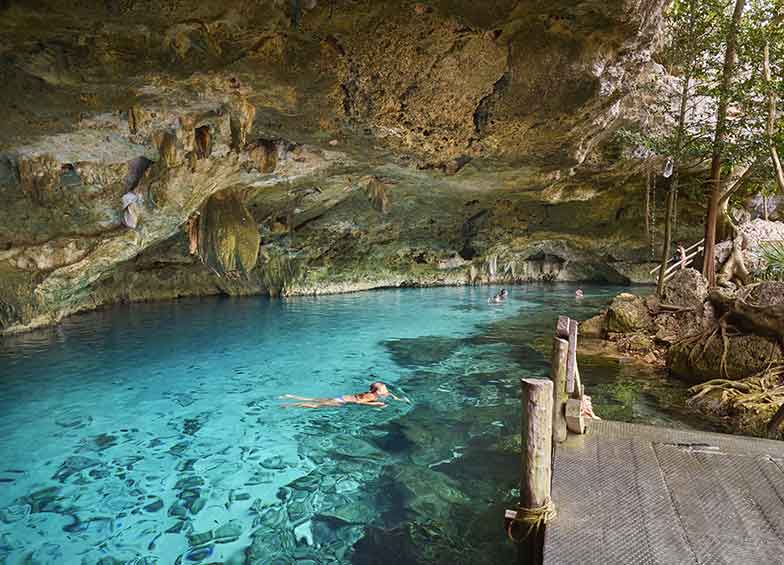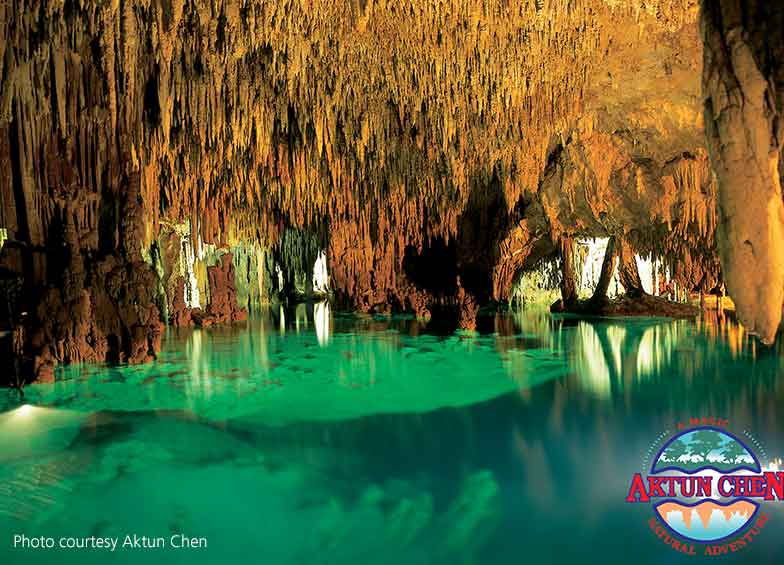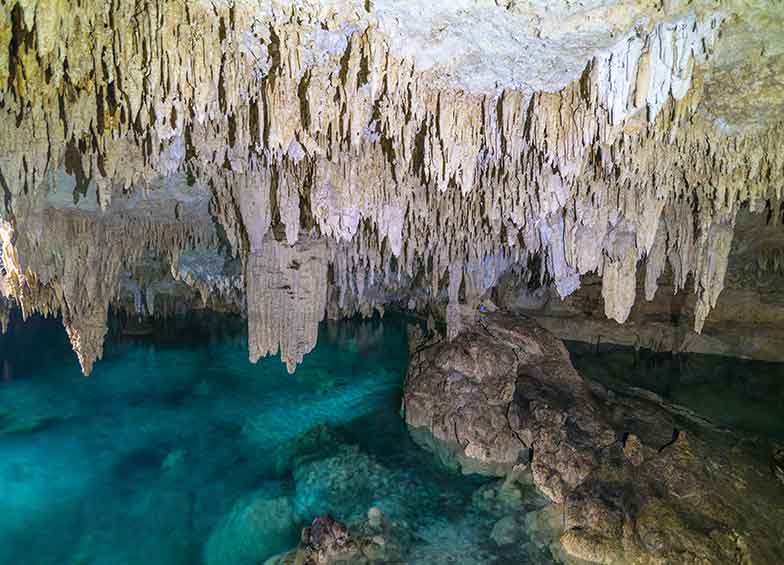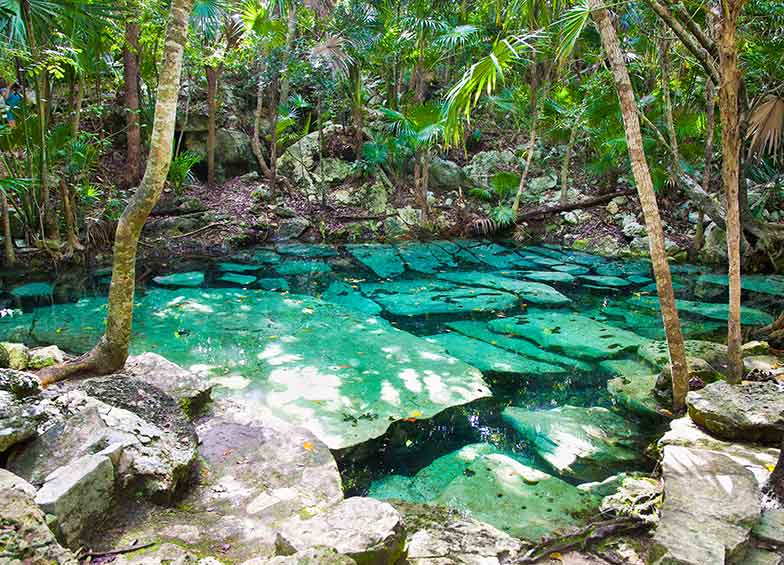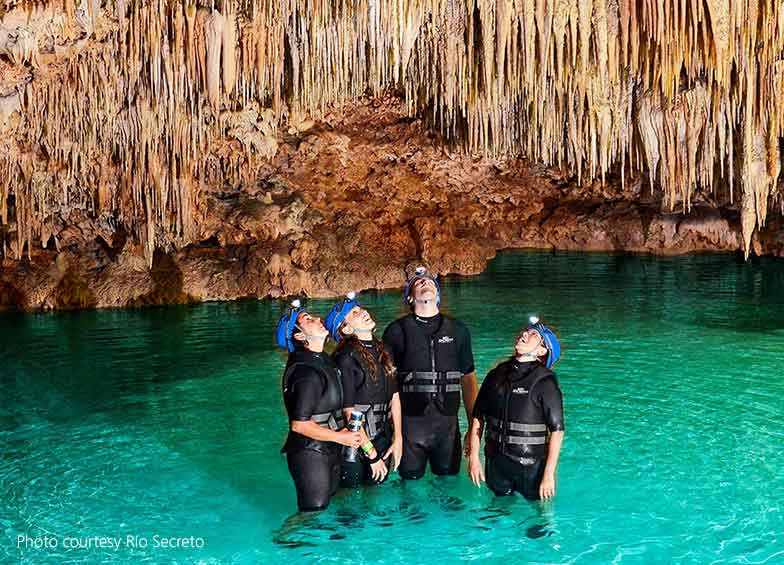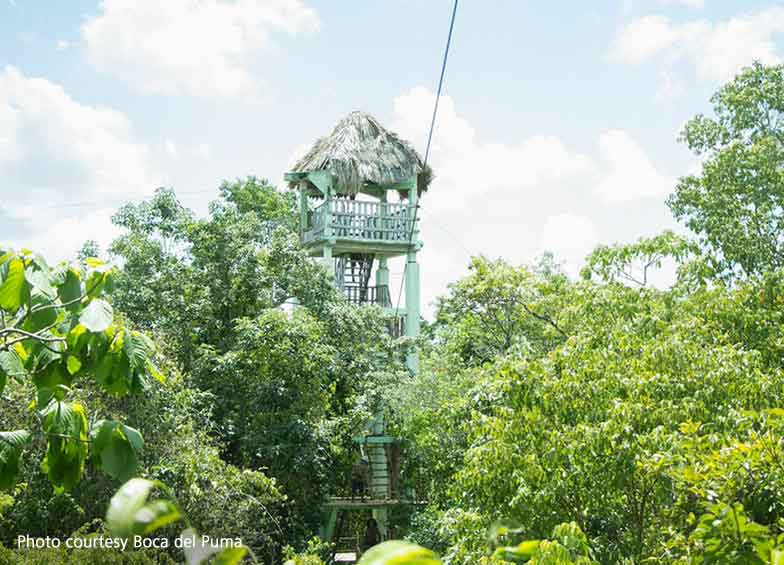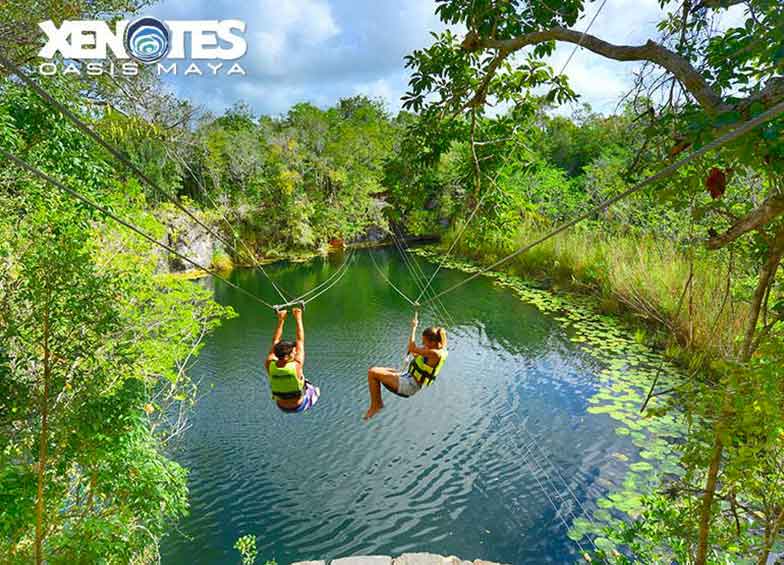Traveling to Cancun or the Riviera Maya soon? Beat the heat with a cooling dip in the crystal-clear waters of a jungle cenote this summer. The limestone landscape of the Yucatan Peninsula is peppered with caves and natural wells or sinkholes called cenotes, which are gateways to a hidden world, a labyrinth of underground rivers. The ancient Maya venerated them as sacred places and they still have an aura of mystery. Join us on a journey to some of the most beautiful caves and cenotes in the Riviera Maya.
What is a cenote?
The Yucatan Peninsula is a vast limestone shelf with no surface rivers. Rainwater seeps through fissures and fault lines in the rock and accumulates in aquifers and underground rivers, which are the only source of fresh water in the area.
The word “cenote” is derived from the Maya word d’zonot or ts’ono’ot which means “flooded cave,” “abyss” or “depths.” They are formed over thousands of years as rainwater reacts with the porous limestone to form carbonic acid, which dissolves, erodes and weakens the rock. Over time, the fissures are enlarged and tunnels and caves are formed. Erosion is twofold, from rainwater on the surface and the underground rivers flowing through the rock. Eventually the rock becomes so unstable that huge slabs carve off and cave roofs collapse, leading to the creation of sinkholes.
Cenotes can be deep lakes or shallow pools and they may suddenly appear as a result of subsidence and a rock fall in a cave. There are several different types of sinkholes: open cenotes are those in which the ancient cave roof has collapsed completely. Partially open cenotes still have a section of the cave roof, there are still others that have a small opening in the roof through which sunlight and the roots of jungle trees filter in and there are cenotes in caves along the course of underground rivers.
The number of these enigmatic natural wells scattered through the peninsula is unknown, in the state of Yucatan alone there may be as many as 8,000, some of which are the source of legends.
The Maya believed that cenotes were sacred places – they were associated with the rain god, Chaac, and were the gateway to Xibalba, the Underworld, the domain of the gods. Even today, some communities believe that the aluxes or spirits that are the guardians of the cornfields dwell in caves and cenotes and others tell of mythical creatures such as golden crocodiles or huge serpents.
Visiting cenotes in the Riviera Maya and Yucatan is an unforgettable experience. Their cool crystal-clear waters are inviting and a welcome surprise after the steamy midday heat. As you swim or snorkel, look down into the depths and marvel at Mother Nature. You’ll see pillars and sculpted columns that look like the turrets and spires of a submerged city and in the distance the black holes of caves and tunnels leading into the unknown.
Here’s a guide to some of the most beautiful cenotes in the Riviera Maya
Dos Ojos Cenote Park
A visit to the Dos Ojos Cenote Park gives you the chance to explore the mysterious underworld of the Yucatan, the intricate labyrinth of caves and underground rivers deep in the limestone rock.
Dos Ojos is the site of two of the longest underground rivers in the world and some of the Riviera Maya’s most beautiful cenotes or sinkholes. With a guide you’ll go snorkeling in several cenotes or sinkholes, try zip lining and enjoy a day in the jungle.
Dos Ojos Park is also home to the Museum of Prehistory, which casts light on the amazing discoveries of fossils and the bones of the earliest humans to settle the Yucatan Peninsula made by archaeologists and cave divers during ongoing explorations of area cenotes.
Aktun Chen
The Aktun Chen cave system lies in the jungle just south of Akumal. There are spotlights in one of the three galleries to show the turquoise waters of the cenote and the delicate beauty of the stalactites, stalagmites and flowstones sculpted by water and calcite over millions of years.
Zip lining, swimming and wildlife watching – spider monkeys, coatimundis and toucans are local inhabitants – are other activities available in Aktun Chen park.
Nohoch Nah Chich
This incredible cenote is the mouth of Sac Actun, the longest underground river system in the world (almost 154 kilometers explored to date).
The Jungla Maya trip offered by Alltournative gives you the opportunity to participate in eight different activities in one day: swimming and snorkeling in Nohoch Nah Chich and Yaxmuul cenotes, abseiling, zip lining, a 4×4 Unimog ride, biking and walking along forest trails and watching a Mayan priest perform a ritual venerating the ancient gods and nature itself.
Cenotes in the Puerto Aventuras Area
A cluster of cenotes lies in the forest to the west of Highway 307 between Puerto Aventuras and Akumal. One mile south of Puerto Aventuras is the Kantun Chi eco-park where two majestic caves and four cenotes (Kantun Chi, Sas Ka Leen Ha, Uchil Ha and Zacil Ha) will surprise even the most intrepid traveler. Cenote Azul is another large jungle cenote with several inlets for snorkeling. The water is so tempting that you may not be able to resist the urge to take a running jump!
Christened by divers, Taj Mahal is one of the most spectacular in the area; shafts of sunlight like an underwater laser show illuminate endless vistas stretching into the distance. Even more poetically named is Jardín del Edén or Garden of Eden, a large cenote rich in marine life and rimmed by exuberant vegetation that is ideal for an afternoon picnic.
Rio Secreto
Rio Secreto is another labyrinth of limestone caves and still clear pools that mirror intricate columns, stalactites and stalagmites. Guided tours available through this hidden treasure.
Exploring the Ruta de los Cenotes
Have you been along the Ruta de los Cenotes, the highway west from Puerto Morelos that leads through the jungle to a chain of beautiful cenotes and eventually links up with the village of Leona Vicario on Highway 180? Rustic signs indicate turn offs for jungle trails leading to cenotes open to the public such as Las Mojarras where you can zip line, dive in from a tower or just enjoy the view.
The seven mouths that give the Siete Bocas cenote its name glow gently as the sunlight penetrates the turquoise depths. The strange rock formations in this cenote are incredible.
Next stop along the Ruta de los Cenotes is the mysterious underground pool of Boca de Puma. Located in a private jungle reserve, this cenote offers a variety of adventures ranging from snorkeling and zip lining to rock climbing, rappelling down a cliff wall and biking. Finally, follow a winding trail to Verde Lucero, an open cenote in a forest clearing where another rustic zip line provides hours of fun.
Xenotes Oasis Maya
The Xenotes Oasis Maya trip gives you the chance to explore four very different cenotes in one day, trying your hand at snorkeling, zip lining and kayak. The four cenotes are named in Maya after the four elements: K’áak or Fire, Há or Water, Lik’ or Wind and Lu’um or Earth. All are filled with crystal-clear water and strange rock formations, and each has its own charm.
Expert guides point out native flora and fauna as they escort you along jungle trails, explaining how cenotes are formed and their importance as sacred sites for the ancient Maya. They will also tell them about Mayan mythology, including the tale of the Aluxes, the guardian spirits of the forest and the milpa or cornfields. Xenotes, Oasis Maya is for small groups of visitors and includes the use of snorkeling gear and a life jacket, a gourmet picnic and transport.
Stay posted for more on cenotes to visit in the neighboring state of Yucatan and on cenote exploration next month on this blog.
Booking Riviera Maya cenote trips
Thomas More Travel offers trips to these Riviera Maya cenote parks and to many more in the Riviera Maya and the Yucatan.
Cenote tips
Do not apply sun cream if you are going to swim in cenotes as it pollutes the water. When visiting cenotes always follow instructions of your guide and park staff. Never swim alone. Do not venture into cenotes or areas of water where swimming is expressly prohibited and do not venture into tunnels.

